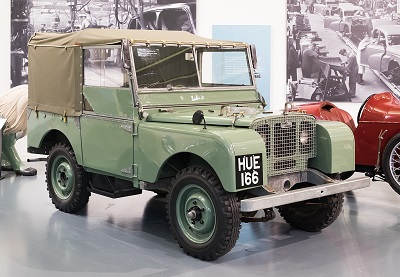A true icon of the once-mighty British automobile industry made its first appearance 70 years ago today at the 1948 Amsterdam Motor Show.
The original Land Rover – later dubbed the Series I – was a post-war utilitarian vehicle mostly aimed at the agricultural market and a million miles from today’s plush and high-tech Range Rover models, but it was the great-granddaddy of them all.
T he Land Rover was conceived by the Rover Company in 1947 in the aftermath of the Second World War. Before the war Rover produced luxury vehicles, but there was almost no demand for them in the austere post-war years and raw materials for manufacturing were strictly rationed. Instead Rover had to refocus on small, affordable economical cars to suit various purposes.
he Land Rover was conceived by the Rover Company in 1947 in the aftermath of the Second World War. Before the war Rover produced luxury vehicles, but there was almost no demand for them in the austere post-war years and raw materials for manufacturing were strictly rationed. Instead Rover had to refocus on small, affordable economical cars to suit various purposes.
It was the company’s chief designer, Maurice Wilks, who came up with the idea to produce a light agricultural and utility vehicle to help Britain’s farmers get back on their feet. It was inspired by the American Willys Jeep, which came to Britain with the GIs during the war. Many remained in Britain and had been sold off as ‘surplus’ after the war, but they were unreliable, unsuited to the British climate, and Wilks – who used a Willys Jeep on his own farm in Anglesey – felt he could do better.
His first prototype, built on a Jeep chassis, had a centre mounted steering wheel and used the engine and gearbox from a Rover P3 saloon car. Bodywork was handmade from an aluminium/magnesium alloy, which avoided the use of rationed steel and was also resistant to corrosion. Paint was also rationed, but Rover produced aircraft during the war and still had supplies of light green cockpit paint, which it decided to use up on the Land Rover.
It had selectable four-wheel drive and a low-range gearbox, making it ideal for off-road use. Another useful addition was a ‘power take-off’ (PTO) similar to those on tractors and which could be used to drive various pieces of agricultural machinery. It made the Land Rover a useful hybrid between a heavy and slow tractor and a faster, lighter but ‘road-bound’ truck.
In tests during 1947 Wilks’ prototype proved a capable and versatile machine, but the tractor-like centre steering wheel proved impractical and was switched to a conventional right-had-drive setup. The bodywork was also simplified to save production time and costs, using a removable canvas roof and rear side panels. A bigger 1.6 litre petrol engine and specially designed gearbox were fitted and the Jeep chassis was replaced with a shorter and sturdier 80-inch box-section steel chassis.
The end result was a vehicle that no longer used any Jeep components and was wider, heavier, faster and better-suited to the job for which it was designed. It was also built to be simple to use and easy to repair, so that farmers – accustomed to working on their own machinery – or local mechanics could maintain the hardy Land Rover at minimal cost.
Originally the utilitarian Land Rover was only intended to be in production for two or three years to bridge the gap until Rover could resume full production of its road cars, but the company did not realise just how popular its distinctive new all-purpose vehicle would become. Unveiled on April 30th at the 1948 Amsterdam Motor Show, it grabbed the attention, outshining sleek sports cars or plush saloons which few could afford or aspire to.
Early sales were better than expected and significantly boosted when the military and police forces began taking an interest and placing orders. It encouraged Land Rover to devote more resources to its unexpected hit, designing new modifications, optional extras and specialised variants. Private buyers also began modifying their Land Rovers to suit their particular needs and soon they were being exported overseas, where their rugged simplicity was greatly appreciated.
The rest, as they say, is history, with new generations of the Land Rover developed and produced at Rover’s Solihull factory, where the one-millionth Land Rover rolled off the assembly line in 1976. By then a more luxurious version, the Range Rover, was already selling well and other versions, including the Discovery and Freelander, would follow.
Seventy years on, many original Series I Land Rovers are still going strong and highly sought after by collectors. Pictured above is the first production Land Rover, with the registration HUE 166, which is on show at the British Motor Museum in Gaydon, Warwickshire.
